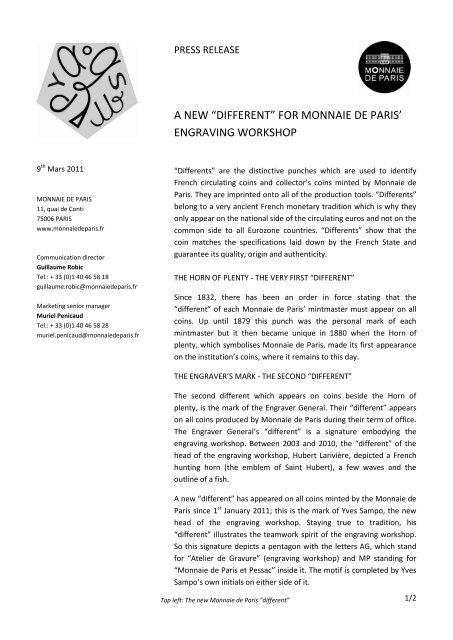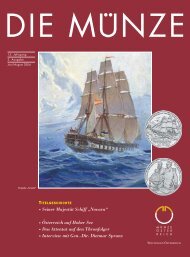for monnaie de paris - Katalog Monet Euro
for monnaie de paris - Katalog Monet Euro
for monnaie de paris - Katalog Monet Euro
Create successful ePaper yourself
Turn your PDF publications into a flip-book with our unique Google optimized e-Paper software.
9 th Mars 2011<br />
MONNAIE DE PARIS<br />
11, quai <strong>de</strong> Conti<br />
75006 PARIS<br />
www.<strong>monnaie</strong><strong>de</strong><strong>paris</strong>.fr<br />
Communication director<br />
Guillaume Robic<br />
Tel.: + 33 (0)1 40 46 58 18<br />
guillaume.robic@<strong>monnaie</strong><strong>de</strong><strong>paris</strong>.fr<br />
Marketing senior manager<br />
Muriel Penicaud<br />
Tel.: + 33 (0)1 40 46 58 28<br />
muriel.penicaud@<strong>monnaie</strong><strong>de</strong><strong>paris</strong>.fr<br />
PRESS RELEASE<br />
A NEW “DIFFERENT” FOR MONNAIE DE PARIS’<br />
ENGRAVING WORKSHOP<br />
“Differents” are the distinctive punches which are used to i<strong>de</strong>ntify<br />
French circulating coins and collector’s coins minted by Monnaie <strong>de</strong><br />
Paris. They are imprinted onto all of the production tools. “Differents”<br />
belong to a very ancient French monetary tradition which is why they<br />
only appear on the national si<strong>de</strong> of the circulating euros and not on the<br />
common si<strong>de</strong> to all <strong>Euro</strong>zone countries. “Differents” show that the<br />
coin matches the specifications laid down by the French State and<br />
guarantee its quality, origin and authenticity.<br />
THE HORN OF PLENTY - THE VERY FIRST “DIFFERENT”<br />
Since 1832, there has been an or<strong>de</strong>r in <strong>for</strong>ce stating that the<br />
“different” of each Monnaie <strong>de</strong> Paris’ mintmaster must appear on all<br />
coins. Up until 1879 this punch was the personal mark of each<br />
mintmaster but it then became unique in 1880 when the Horn of<br />
plenty, which symbolises Monnaie <strong>de</strong> Paris, ma<strong>de</strong> its first appearance<br />
on the institution’s coins, where it remains to this day.<br />
THE ENGRAVER’S MARK - THE SECOND “DIFFERENT”<br />
The second different which appears on coins besi<strong>de</strong> the Horn of<br />
plenty, is the mark of the Engraver General. Their “different” appears<br />
on all coins produced by Monnaie <strong>de</strong> Paris during their term of office.<br />
The Engraver General’s “different” is a signature embodying the<br />
engraving workshop. Between 2003 and 2010, the “different” of the<br />
head of the engraving workshop, Hubert Larivière, <strong>de</strong>picted a French<br />
hunting horn (the emblem of Saint Hubert), a few waves and the<br />
outline of a fish.<br />
A new “different” has appeared on all coins minted by the Monnaie <strong>de</strong><br />
Paris since 1 st January 2011; this is the mark of Yves Sampo, the new<br />
head of the engraving workshop. Staying true to tradition, his<br />
“different” illustrates the teamwork spirit of the engraving workshop.<br />
So this signature <strong>de</strong>picts a pentagon with the letters AG, which stand<br />
<strong>for</strong> “Atelier <strong>de</strong> Gravure” (engraving workshop) and MP standing <strong>for</strong><br />
“Monnaie <strong>de</strong> Paris et Pessac” insi<strong>de</strong> it. The motif is completed by Yves<br />
Sampo’s own initials on either si<strong>de</strong> of it.<br />
Top left: The new Monnaie <strong>de</strong> Paris “different”<br />
1/2
THE ENGRAVERS GENERAL OF CURRENCY<br />
The position of Engraver General of Currency was created in 1547, at a<br />
time when there were mints scattered all over France. Back in those<br />
days the Engraver General used to cut the original punches, which<br />
were then sent out to all the different mints.<br />
MONNAIE DE PARIS ENGRAVERS GENERAL SINCE 1547<br />
1547 - 1557 Marc Béchot<br />
1557 - 1582 Clau<strong>de</strong> <strong>de</strong> Héry<br />
1582 - 1599 Philippe Danfrie (the el<strong>de</strong>r)<br />
1599 - 1604 Philippe Danfrie (the younger)<br />
1605 - 1625 Nicolas Briot<br />
1626 - 1630 Pierre Régnier<br />
1630 - 1646 Jehan Darmand<br />
1646 - 1672 Jean Warin<br />
1672 - 1681 François Warin<br />
1682 - 1703 Joseph Roettiers<br />
1704 - 1727 Norbert Roettiers<br />
1727 - 1753 Joseph-Charles Roettiers<br />
1753 - 1772 Charles-Norbert Roettiers<br />
1772 - 1774 Joseph-Charles Roettiers<br />
1774 - 1791 Pierre-Simon-Benjamin Duvivier<br />
1791 - 1803 Augustin Dupré<br />
1803 - 1816 Pierre-Joseph Tiolier<br />
1816 - 1842 Nicolas-Pierre Tiolier – Horse’s head and star<br />
1843 - 1855 Jacques-Jean Barre – Greyhound’s head<br />
1855 - 1878 Albert Désiré Barre - Anchor<br />
1879 - 1880 Auguste Barre - Anchor with a bar<br />
1880 - 1896 Jean Lagrange – Fasces of lictor<br />
1896 - 1930 Henry Patey - Torch<br />
1931 - 1957 Lucien Bazor – Bird’s wing<br />
1957 - 1974 Raymond Joly - Owl<br />
1974 - 1994 Emile Rousseau - Dolphin<br />
1994 - 2000 Pierre Rodier - Bee<br />
THE HEADS OF THE ENGRAVING WORKSHOP<br />
The role played by the heads of the engraving workshop involves<br />
coordinating staff and looking after product quality control.<br />
2000 - 2002 Gérard Buquoy - Horseshoe<br />
2002 - 2003 Serge Levet - Heart<br />
2003 - 2010 Hubert Larivière – Hunting horn<br />
Since 2011: Yves Sampo – “Fleurette d’atelier”<br />
2/2



